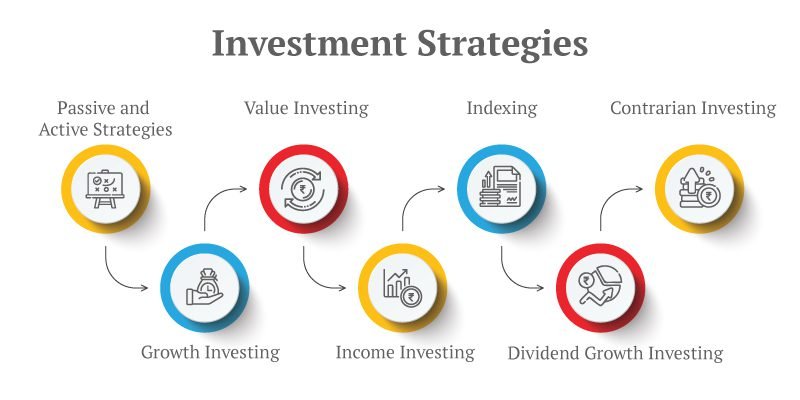Navigating the Spectrum of Investment Strategies
Introduction: Investing is a nuanced practice, requiring a personalized approach tailored to individual financial objectives, risk tolerance, and market dynamics. With a multitude of investment strategies available, investors are empowered to craft their unique paths towards financial success. In this exploration, we’ll traverse through various investment strategies, each offering distinctive advantages and considerations.
-
Value Investing:
- This strategy, famously endorsed by Warren Buffett, revolves around identifying undervalued stocks trading below their intrinsic value.
- Value investors scrutinize companies with robust fundamentals but underpriced stock valuations.
- Key metrics like price-to-earnings ratio (P/E), price-to-book ratio (P/B), and dividend yield serve as guiding lights for value investors.
-
Growth Investing:
- Growth investors concentrate on companies poised for above-average growth in earnings and revenue.
- They prioritize entities demonstrating strong sales growth, innovative products or services, and expanding market presence.
- Sectors such as technology, healthcare, and consumer discretionary often attract growth investors due to abundant growth prospects.
-
Dividend Investing:
- Dividend investing entails acquiring stocks offering regular dividend payments.
- Investors seeking consistent income streams and potential long-term capital appreciation favor dividend-yielding stocks.
- Companies with reliable and escalating dividends are particularly appealing to dividend investors.
-
Income Investing:
- Income investors prioritize generating a steady income stream from investments.
- This strategy involves allocating capital to assets like bonds, real estate investment trusts (REITs), and dividend-paying stocks.
- Fixed-income securities, with predictable interest payments, form a cornerstone of income investing portfolios.
-
Index Investing:
- Index investing, or passive investing, involves mirroring the performance of a market index like the S&P 500.
- Instead of striving to outperform the market, index investors aim to replicate its performance.
- Exchange-traded funds (ETFs) and index mutual funds are favored vehicles for executing this strategy, offering low fees and broad diversification.
-
Momentum Investing:
- Momentum investors leverage market trends, capitalizing on securities exhibiting robust recent performance.
- This strategy entails purchasing assets with upward momentum, anticipating the trend to persist.
- Vigilant monitoring of price trends and trading volumes is paramount for momentum investors.
-
Contrarian Investing:
- Contrarian investors defy prevailing market sentiment, seeking undervalued assets overlooked by the crowd.
- This strategy involves buying when others are selling and vice versa, based on contrarian convictions.
- Market sentiment indicators and valuation metrics are pivotal tools for contrarian investors.
-
Asset Allocation:
- Asset allocation involves diversifying investments across various asset classes such as stocks, bonds, and cash.
- The objective is to construct a balanced portfolio that mitigates risk and maximizes returns, aligned with the investor’s risk profile and investment horizon.
- Strategies encompassing strategic, tactical, and dynamic asset allocation contribute to effective portfolio management.

Conclusion:
Investment strategies serve as guiding principles in navigating the financial markets, facilitating the attainment of diverse financial objectives. Each strategy presents its own set of merits, risks, and considerations, catering to the multifaceted needs of investors. Successful investment endeavors often entail a blend of strategies customized to individual circumstances and aspirations. By comprehending the spectrum of investment strategies, investors can embark on informed decision-making journeys, aligning their actions with their financial goals and preferences.



